

Full Stack web developer with experience across the MERN stack

Devoted traveller and explorer with DINKWAD aspirations
Full Stack web developer with experience across the MERN stack

Devoted traveller and explorer with DINKWAD aspirations
I am an established professional with skills in full-stack web-development, business strategy and management. My professional experiences include working in event-planning, with charities, with investors and most recently in founding a professional skills training business in Sierra Leone.
This breadth of experience, both as an employee and a business owner, has exposed me to a wide variety of challenges and problems which I have relished solving. I am looking forward to deploying my recent software engineering training by leveraging my experience and skills in a new, more technical environment.
I try and live my life to the max - never shying away from challenges and opportunities. In 2023 I got married to the wonderful Kristie - the latest in a series of adventures!
I've been lucky enough to live abroad and experience life in different parts of the world which has only fuelled my desire to see more. Whether I'm living in a developing country or at home in London, I always try to explore everything with an open-minded approach.
When I'm not planning my next trip, you'll probably find me at a gig or festival, dancing like nobody's watching. Life's too short to take everything too seriously, so I try to have as much fun as possible along the way. Let's go on an adventure together!
Throughout my career I have accumulated a number of self-taught skills, working with established software and by leveraging my Excel skills to design functional, resilient and long-lasting business systems for a range of organisations.
My training as a full-stack web developer in 2022 has provided me with a improved arsenal of technical skills that I can now deploy in any professional situation.

Building basic websites

Building full-stack web apps

Building full-stack web apps

Building full-stack web apps

Budgeting, analysis and reporting

Business logic design and implementation
These are some of the most transformational personal experiences I've had. They are what make me, me.
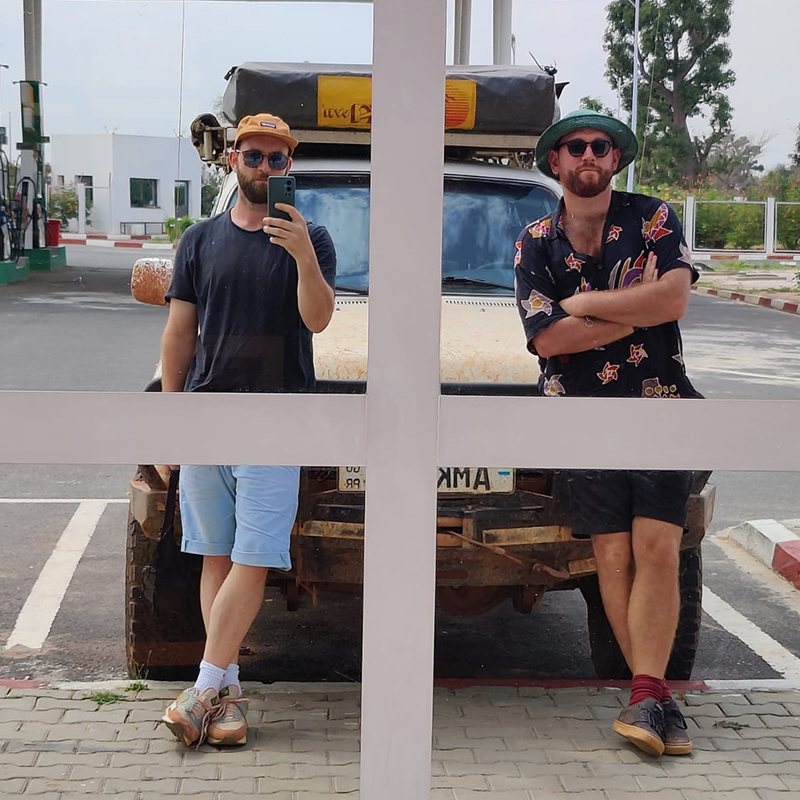
Documentary of an overland trip from the jungle to the desert and beyond.
What a trip!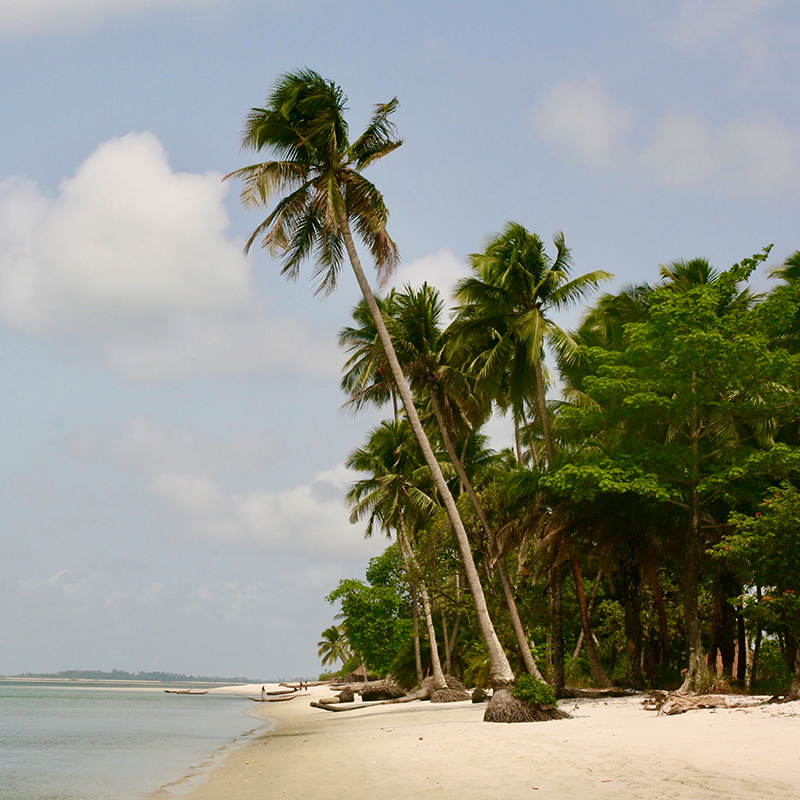
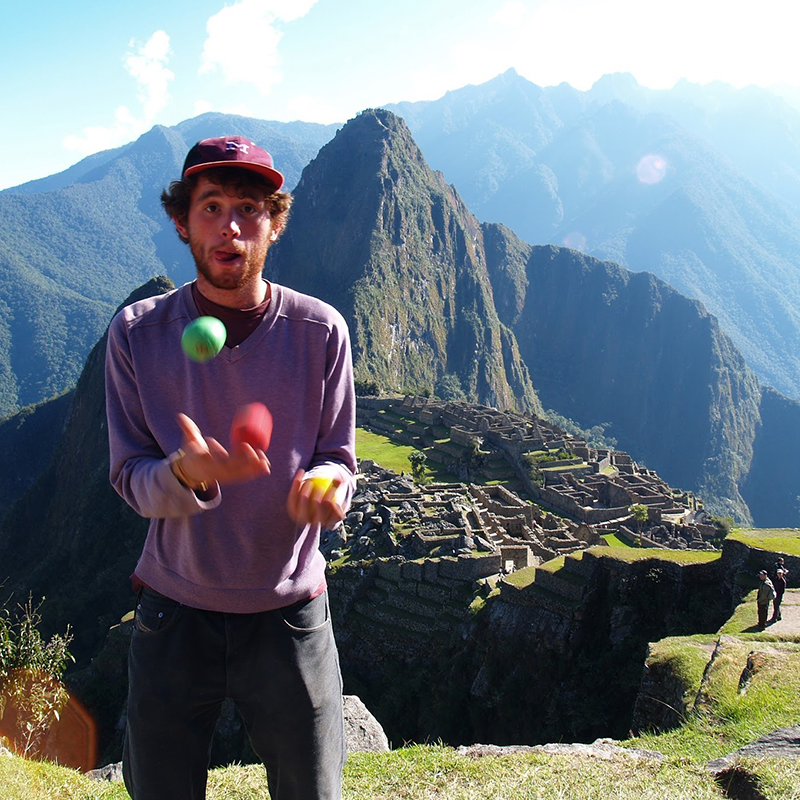
My career as a full-stack web developer is still in its infancy, but I have a portfolio that demonstrates building basic, modern websites and full CRUD applications on a number of stacks.
I have also included links to projects from before my re-training as a full-stack web developer principally to demonstrate my strengths in designing complex data systems and functional business reporting mechanisms.






These are some of the projects that I'm most proud of. I hope you enjoy them too!
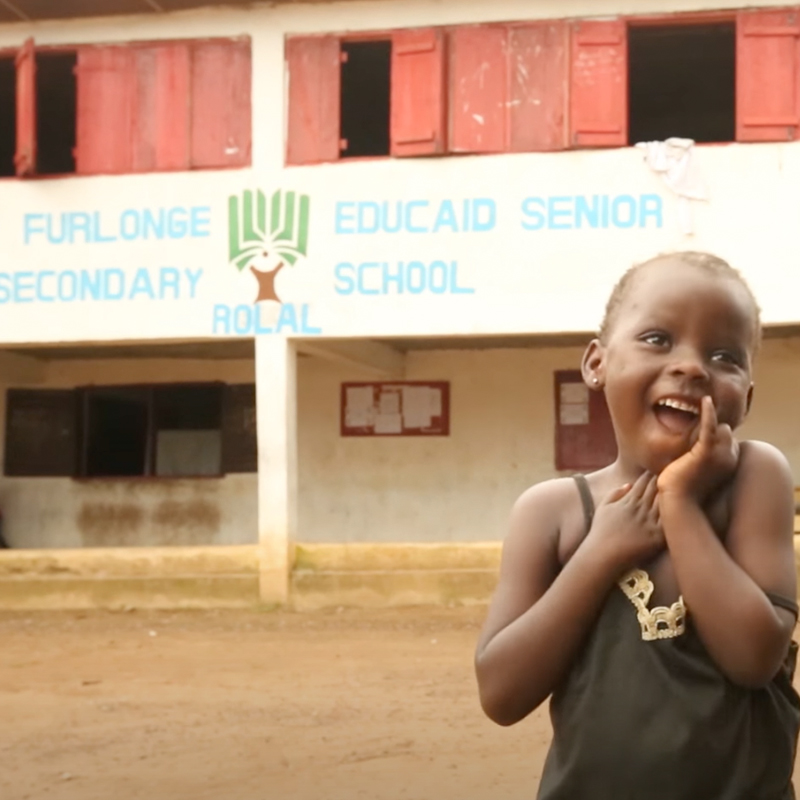
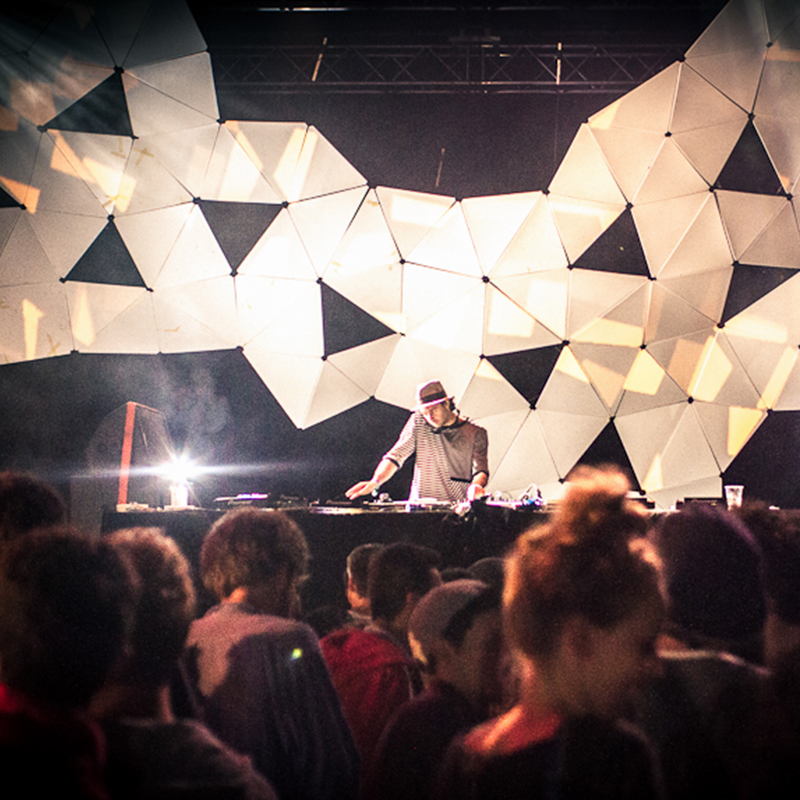
Organising an electronic music festival on the Croatian coast in your early 20s.
Check it out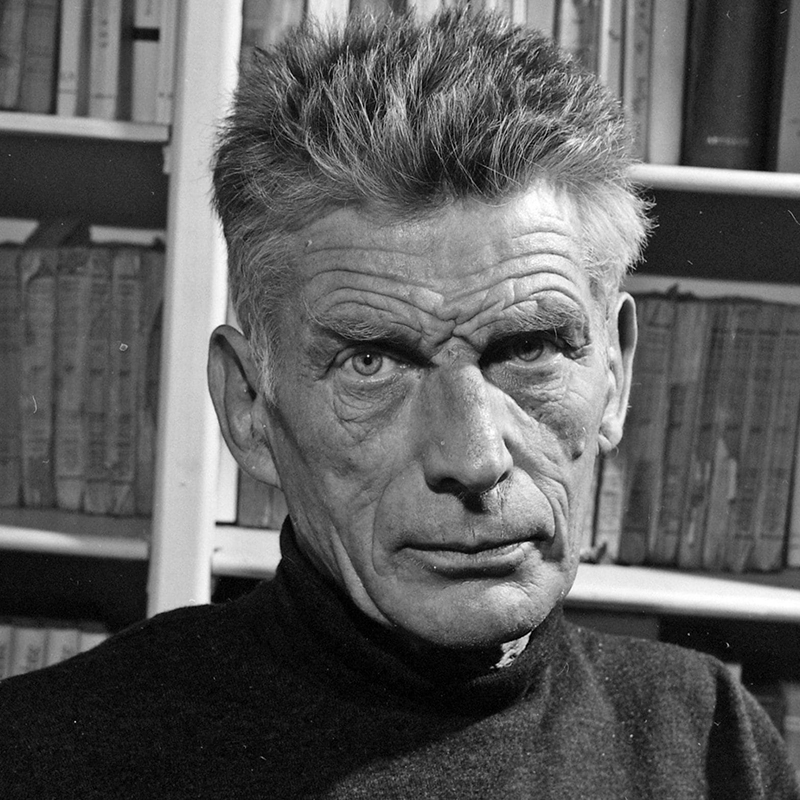
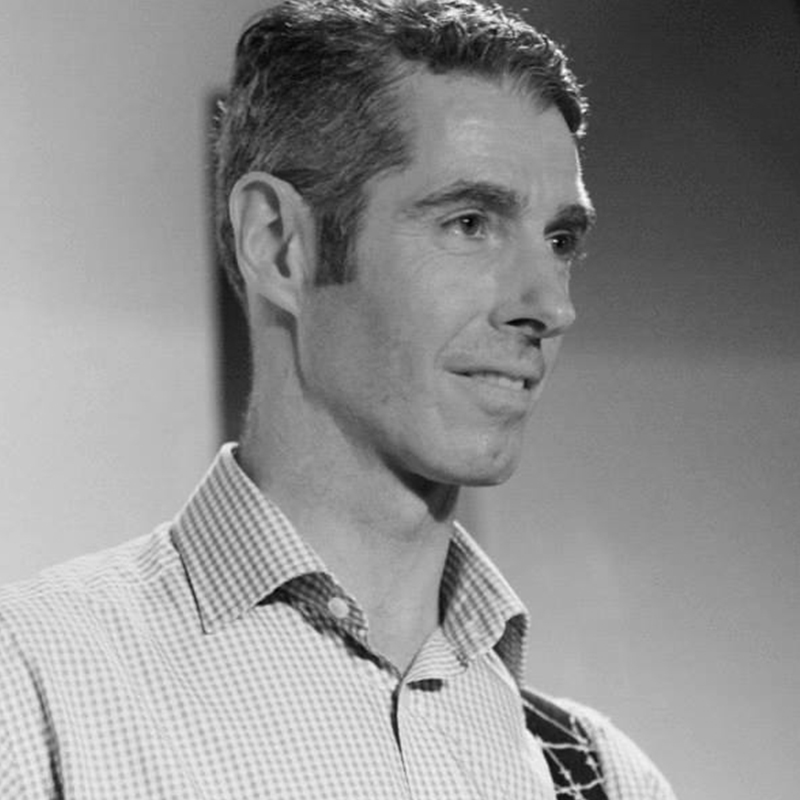
I have had the pleasure of working with Marcus for over 8 years and I can wholeheartedly attest to his exceptional ability, positive attitude, and unwavering dedication to his work.
Throughout his career, Marcus has impressively managed a wide variety of projects and roles across different organisations, consistently demonstrating resilience and leadership in the face of challenging environments and circumstances. He particularly excels in his ability to lead strategic planning, cultivate positive cultures, and drive meaningful outcomes, making him an invaluable asset to any team. He has been able to build a complex solution from concept to implementation on several occasions – an impressive skill that is not easily replicated.
One of Marcus' greatest strengths is his strategic problem-solving ability. He approaches complex issues with thoughtfulness and determination, consistently achieving positive results. As an employer, manager, and co-founder, I have always been impressed by his willingness to go above and beyond to ensure the success of his team and the organisation as a whole.
I am confident that Marcus will bring immense value to any organisation with whom he chooses to work. I wholeheartedly recommend him without hesitation and have no doubt that he will continue to excel in any role he takes on.
Contact Adrian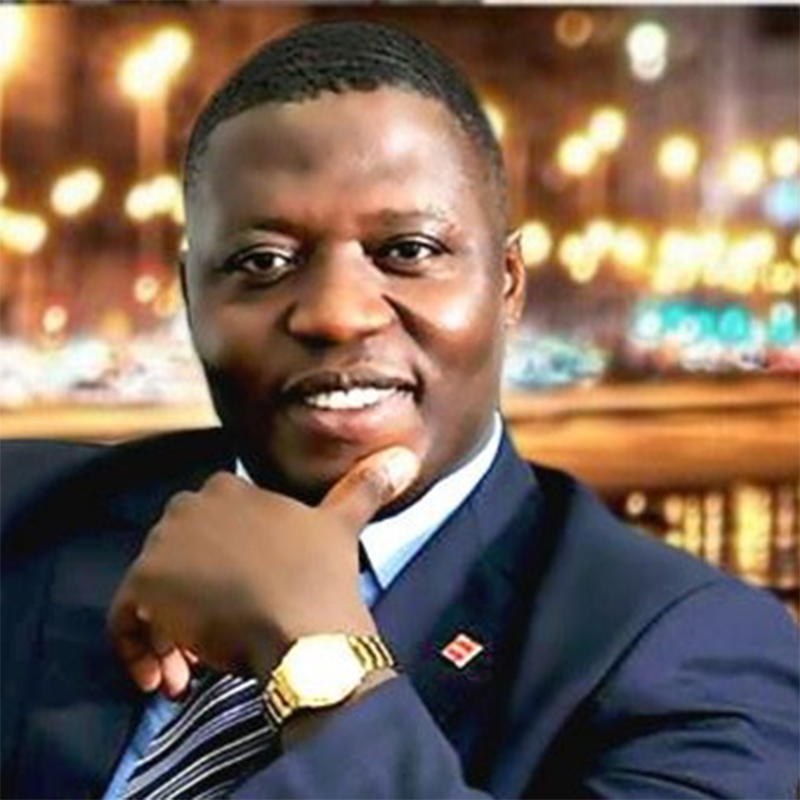
Marcus was critical in managing the merger of four businesses into the LBD Group. As Chief Delivery Officer he was responsible for structuring the group-wide Operations, Finance and HR departments, and for designing and implementing of financial, project-management and performance-management systems and processes that I could use as CEO to manage the teams and run the business.
Marcus’ strengths lie in his ability to design, implement and train staff on tools to strengthen business processes. We are still using the financial and performance-management tools that he built for us!
Marcus demonstrated his commitment to the success of the LBD Group through dedicated, passionate hard work. He was well liked amongst the staff and continues to support my teams in an advisory capacity to this day.
Overall, we were very sad to see Marcus go and we continue to explore ways in which we can work together closely in the future.
Contact Joe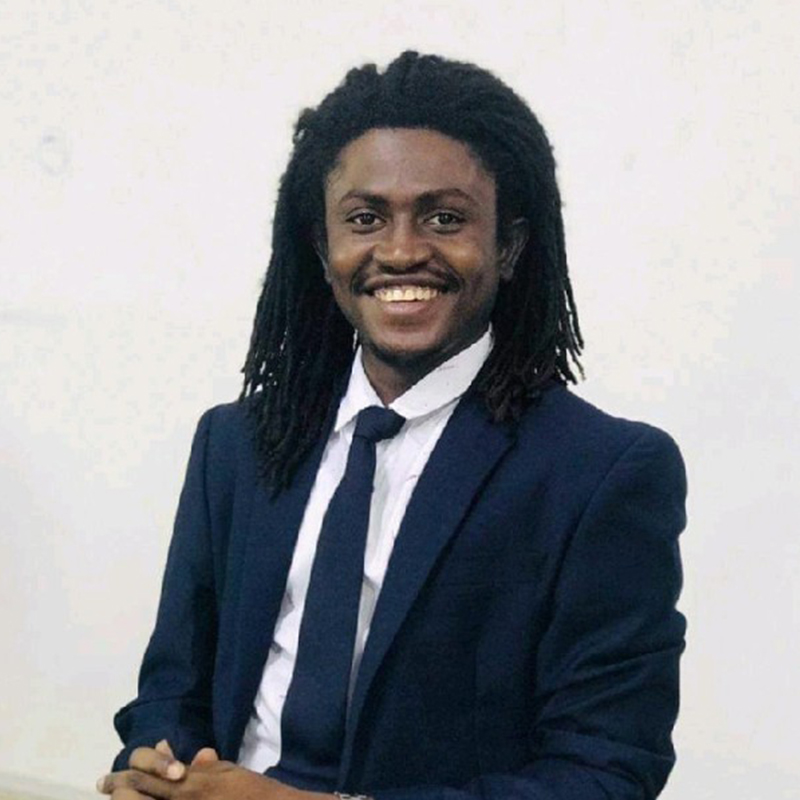
I had the opportunity to have worked with Marcus for a total of 7 years, first at EducAid Sierra Leone where he supported programme delivery work and more recently at Grow Salone where he was co-founder and Managing Director.
Marcus had an unmatched drive for delivering results, yet he always prioritized staff wellbeing. The long hours and quality of work he gave to work was inspiration to all of the teams.
I achieved some of my best in terms of professional growth working under Marcus's supervision at Grow Salone where I worked as Trainer and later Lead Trainer. He empowers you to take ownership of your role. For instance, during one of my performance review sessions with him, he asked me "Is there anything I can do to get out of your way [so you can take increased leadership of the training team]?"
Marcus has a gift for automating processes to drive efficiency and scalability. At EducAid (where I worked as School Leader and Teacher Training Programme Coordinator he built M&E systems that transformed our ability to make informed decisions about students, with intuitive dashboards and user interfaces. His team also visited the schools to monitor system usage, train staff in using the system and resolving issues based on their experience using it. His desire to automate processes made us highly efficient and made new staff onboarding seamless.
Contact Alusine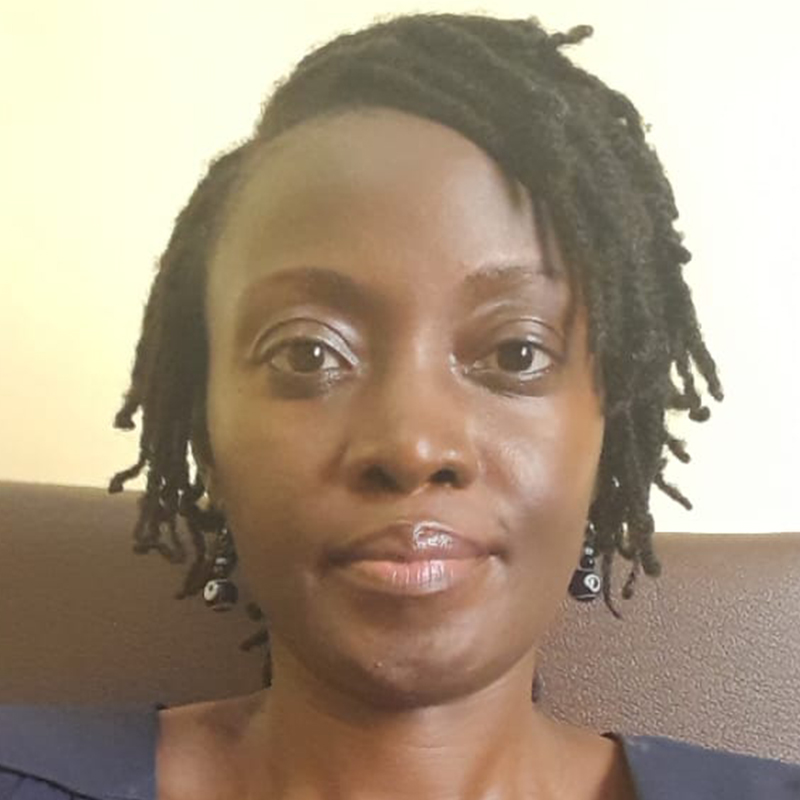
I am writing to commend the work ethics and principles displayed by Marcus as a colleague and Manager in the two years I had the opportunity to work with him as a Lead Trainer at Grow Salone.
Grow Salone is a company in Sierra Leone supporting young people in the early stages of their career and organisations seeking to upgrade the capacity of their staff. They do this through their Professional and Modular Skills Programmes by providing world-class training, recruitment and performance management services. In my first year of employment, Marcus Smith was my supervisor and the Managing Director of Grow Salone. Marcus displayed reliable and consistent work ethics. You can always count on him to deliver work on time, and to provide the necessary support needed by the Team to complete tasks and meet deadlines. He was often the handyman, the troubleshooter-he was always taking the initiative. It was easy to stay motivated and productive when working with Marcus because he was result driven, always bringing positive energy to the team. I was often amazed at the high level of professionalism he displayed. Marcus was respectful, always ready to listen to the ideas of others and encouraged high quality work. He displayed exemplary productivity and integrity which was emulated by team members.
I was recently promoted because of my impressive work ethics. I attribute my success to Marcus who taught me how to be a leader that inspires the trust and commitment of others.
Contact RebeccaI set out to build a full CRUD application single page application using the MERN Stack - the first time I've built an app using React.
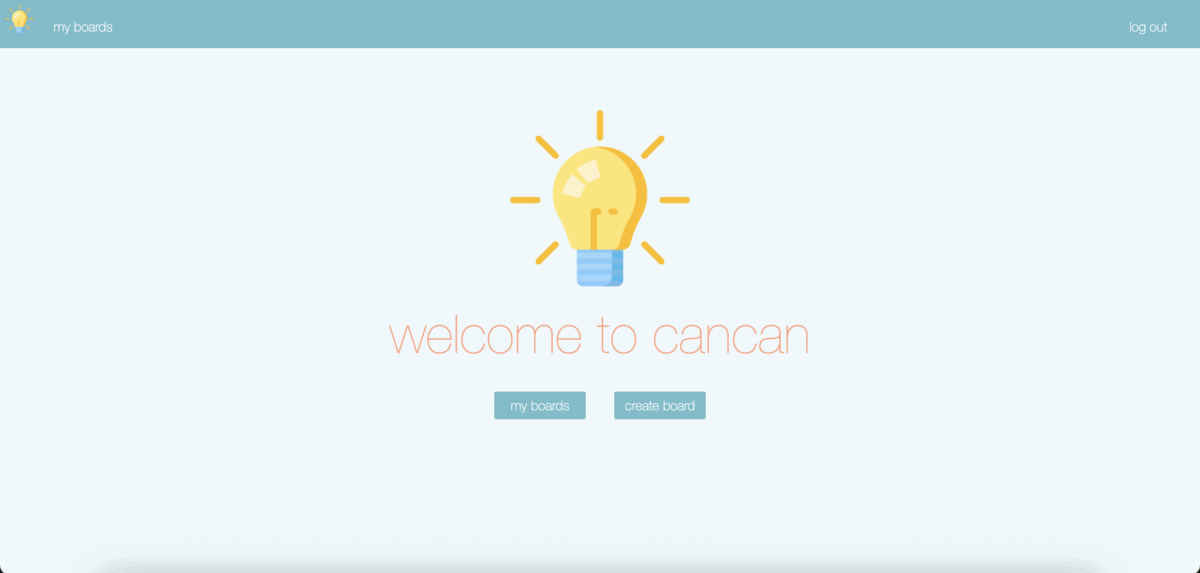
My favourite feature on cancan is the % completion rate that appears when your cursor moves over a board on the 'my boards' page of the app.
I like this feature both because I think it creates a functional and minimalistic UI, and for the logic that went into calculating the completion rate.
Getting my head around React was very challenging at first and it took a lot of research to really understand the flow.
Once I got my head around that, and the concept of state, I found the development process to be fairly straightforward and found the limits of my JavaScript knowledge to be the biggest blocker.
About half way through developing cancan I decided to change how my main data entities were related - from referenced objects to nested objects.
This change meant that I had to refactor more than a dozen controller functions which took a long time. Therefore, my main takeaway would be to plan relationships better!
I set out to build a full CRUD application using the MEN stack - my first project using any of these technologies.
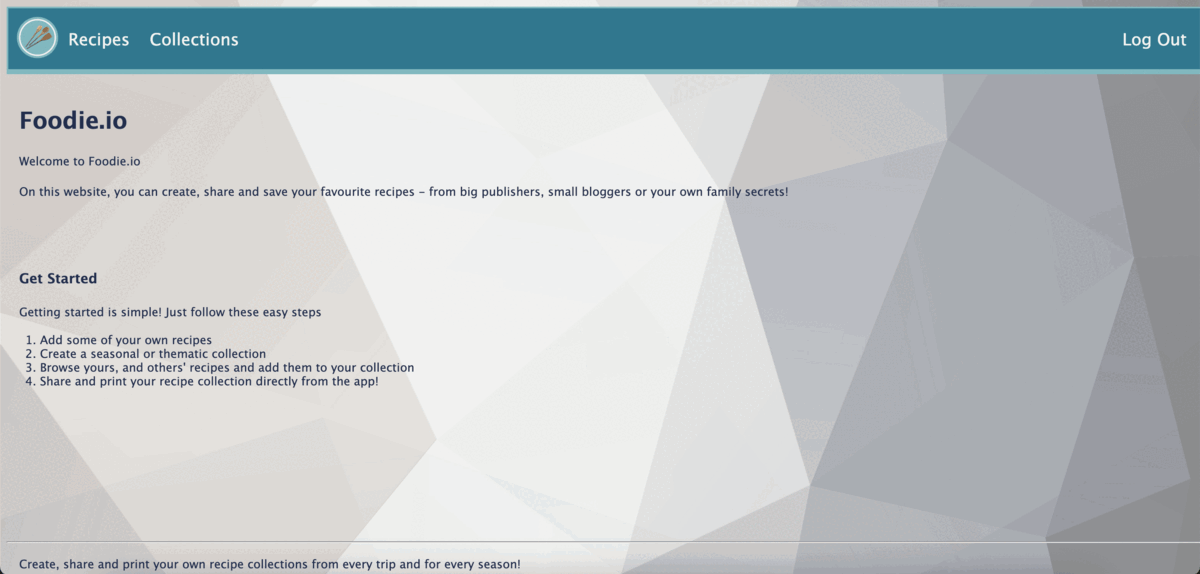
Designing a functional print tool is probably my favourite feature on the app - it was not the most technical, but it makes the app truly functional.
I found adding the instructions and ingredients as nested arrays to an object that was being created in the same user flow to be the most challenging aspect of building this app.
Since I had always hoped for this app to be mobile-friendly, building it following the mobile-first principle would have been a better way of approaching it.
A one-page website using only HTML, JavaScript, and CSS Bootstrap. I set out to test my web development fundamentals by building a one-page website, principally because I like this modern website design and a portfolio would not require any server-side communication that would come about by a single page application built through React.js.
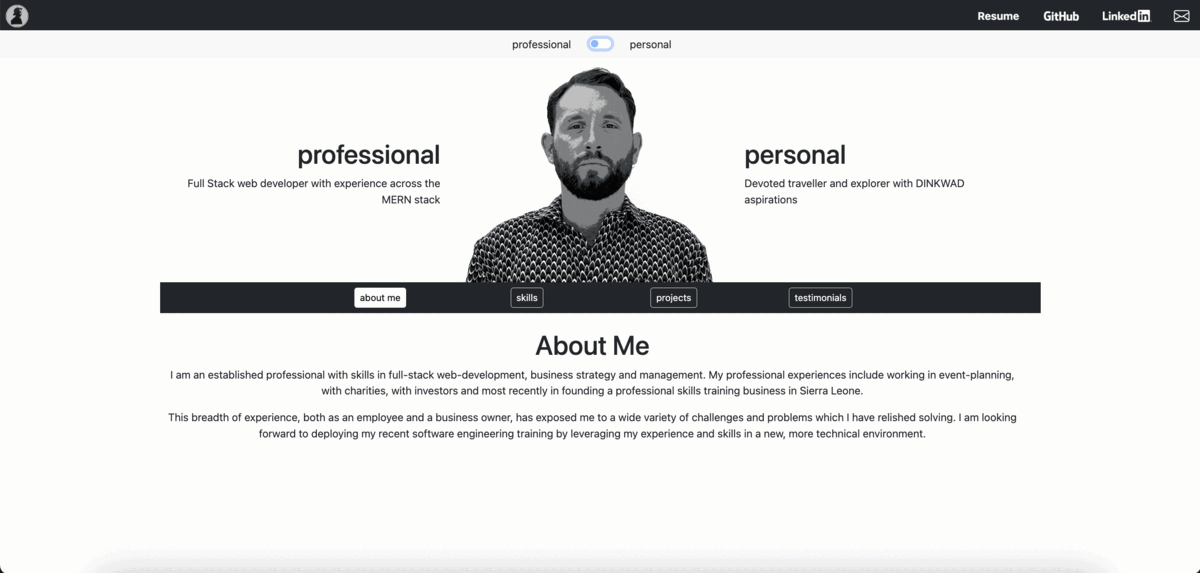
This is a very simple site, but the DOM manipulation was probably the most technical aspect.
My favourite feature is the one-page design, facilitated by DOM manipulations - I like that a user can get a visual and content-based feeling for both sides of my life.
There were no substantial blockers, but managing the state changes was certainly the most demanding aspect of designing this site.
It was also my first time using Bootstrap to style the site. I can see the advantages of using a CSS framework like this but I also do like to be in control...
One page websites can be built with HTML and JavaScript, but the sites do get a little unruly as they get bigger.
In future, I may have chosen to use another platform to design this site, or to have taken a multi-page approach when using HTML, CSS and Javascript.

A browser-based application using HTML, JavaScript, and CSS.

This was the first time that I had built a website using CSS Grids, and I enjoyed being able to set the strict confines of what eventually came to be quite a complicated HTML setup.
The biggest blocker that I faced was how to get a natural flow to the game, most successfully achieved by introducing intervals between dealt cards.
This was a coding challenge, and in future I would be more ambitious in choosing a harder game. Whilst it's possible to introduce more betting logic, the lose/win logic is very simple in Blackjack.
In February of 2019 I secured funding to build a company that would seek to bridge the skills gap between university and the workplace by providing world-class skills training and career-development support. In the course of 3.5 years we developed a proprietary curriculum, grading and reporting system and graduated more than 80 students with an 85% employment rate within 6 months.
As well as supporting individuals, we worked with major international partners to deliver on educational objectives within Sierra Leone.
In mid-2022 we exited Grow Salone by completing its sale into a larger, merged business services group, the LBD Group.
Grow Salone was founded to provide world-class educational services in Sierra Leone, with the specific objective of providing skills that would drive productivity, efficiency and dynamism within the workforce.
The Professional Skills Programme is Grow Salone's flagship course, designed specifically to support entry-level jobseekers into the workplace with the skills to add value to their employers from day one. Our innovative financing and post-graduation support model allowed Grow Salone to invest in their graduates, and to align their careers with the company's commercial performance.
Grow Salone's commercial partners have sought them to design and implement a range of high-quality educational programmes, from in-service training to interactive e-learning design; Grow Salone has worked with some of the best known institutions within Sierra Leone and across global development.
The Professional Skills Programme (PSP) is a 10-week intensive programme that includes training, post-graduation support as well as recruitment services.
Through it's Income Share Agreement financing model - the first deployed in sub-Saharan Africa - Grow Salone aligned itself with the employment outcomes of its graduates, and their employment partners satisfaction.
The Professional Skills Programme contains three distinct stages:
Applicants must pass through a three-stage application process to ensure that they are eligible for the programme. The last of these steps is an in-person examination that covers English language, professional English, verbal literacy, numerical literacy and a typing speed test. Roughly 60% of applicants were invited to join the PSP.
The PSP covers 8 core modules and culminates in a final project.
During the final project, we would invite a real organisation to present our cohorts with a genuine problem that they are facing. Our cohorts would then have a week to research, ideate and present solutions to the problem back to the organisation.
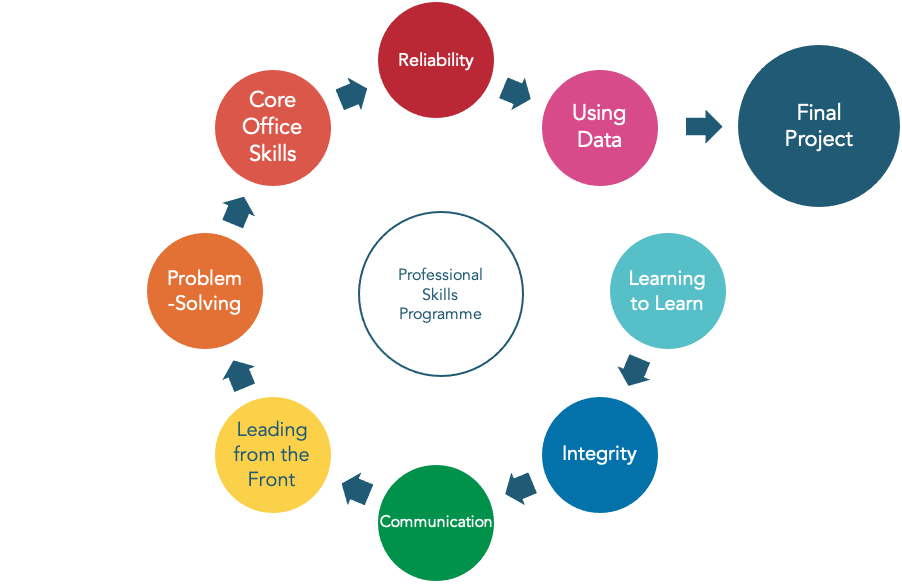
Throughout the PSP we collect three types of data:
Attendance was taken 4 times per day; a minimum of 80% attendance was required within each module and of the programme overall.
Academic understanding was assessed through in-module quizzes, an end-of-module test and end-of-module essays.
Trainees were graded against 75 separate behavioural indicators across 4 groupings: Participation, Approach, Mindset, and Delivery.
Throughout the programme, we collect more than 2,500 individual pieces of data on each graduate. Using Google Classroom and Sheets, I developed a grading and Skills Reporting system which allowed us to serve this information to our employment partners in a digestible format.
You can see an example of the output of this automated grading and reporting system below in Hassan Jalloh's skills report:
The intensive training of the Professional Skills Programme was only part of the offering to our trainees; in order to make our business model functional, and honour our commitment to our trainees, we would support them into employment, and throughout the early stages of their career.
This Post-Graduation included three distinct areas of support:
Following graduation, we would take graduates through a three day employability training covering job-hunting, CV preparation, interview preparation and practice as well as follow-up.
Following graduation, our Professional Pathways department would match our graduates with available employment partner opportunities, supporting in the negotiation of salary and terms.
We would continue to support our graduates and employment partners for up to 3 years following the start of a contract by conducting periodic performance surveys and providing ad-hoc support.
Grow Salone has worked with some of the most recognisable clients within the development sector and in Sierra Leone.
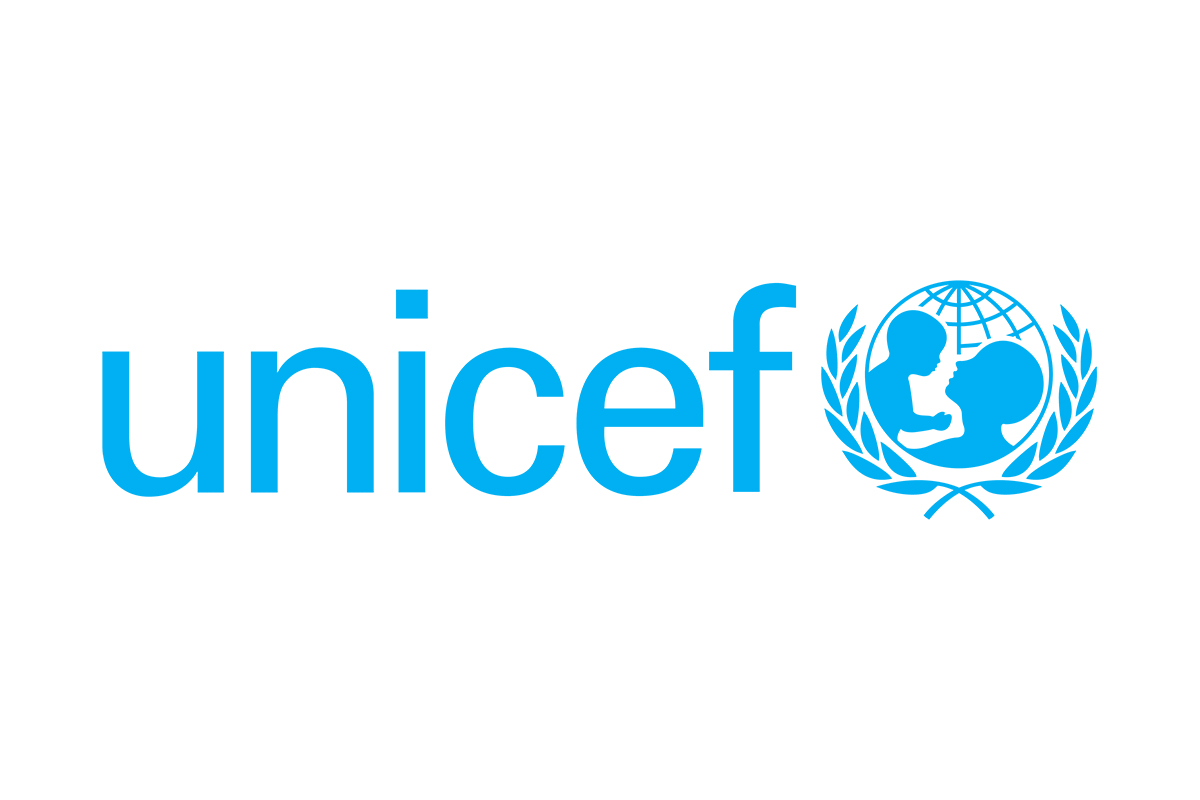
Grow Salone was contracted by UNICEF to adapt sections of it's Professional Skills Programme curriculum for the e-learning platform, the Learning Passport, which has now been launched nationwide through 12 digital skills hubs.
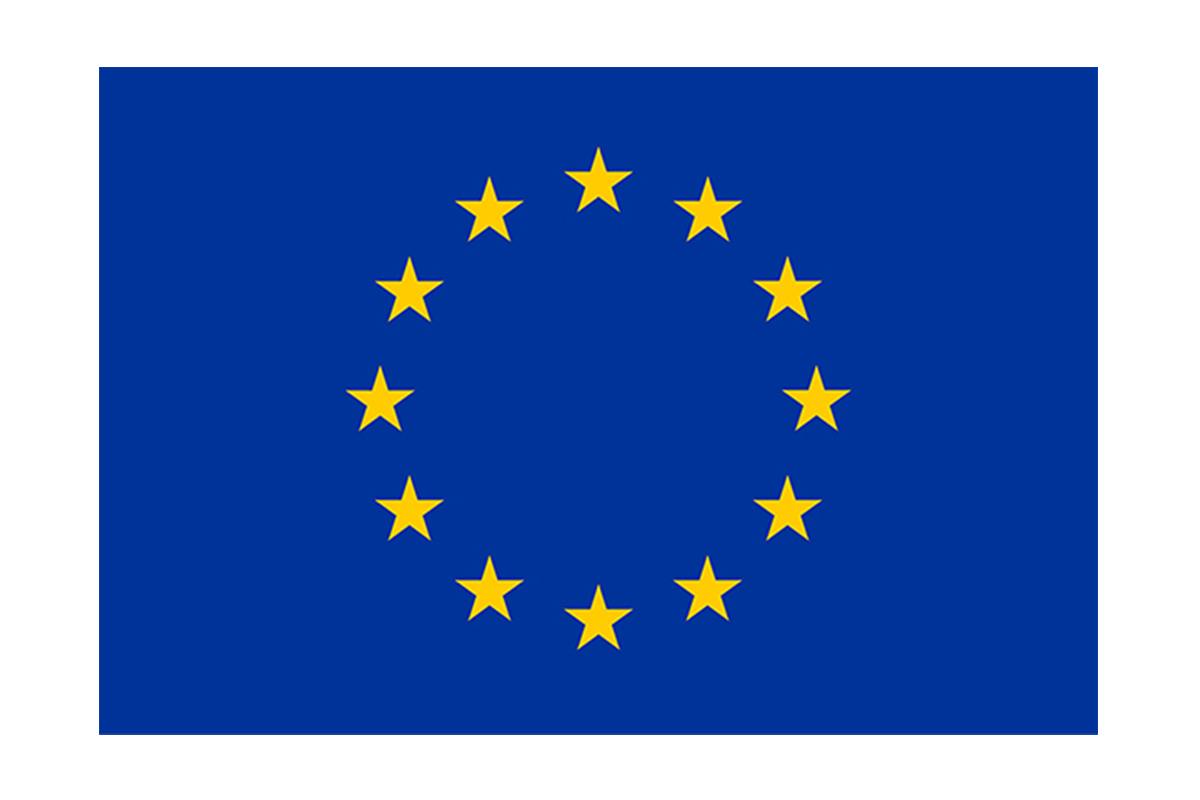
Grow Salone worked with the European Union Delegation in Sierra Leone to conduct a skills assesment of their secretarial staff. Based upon our recommendations we conducted regular training and performance-management sessions.
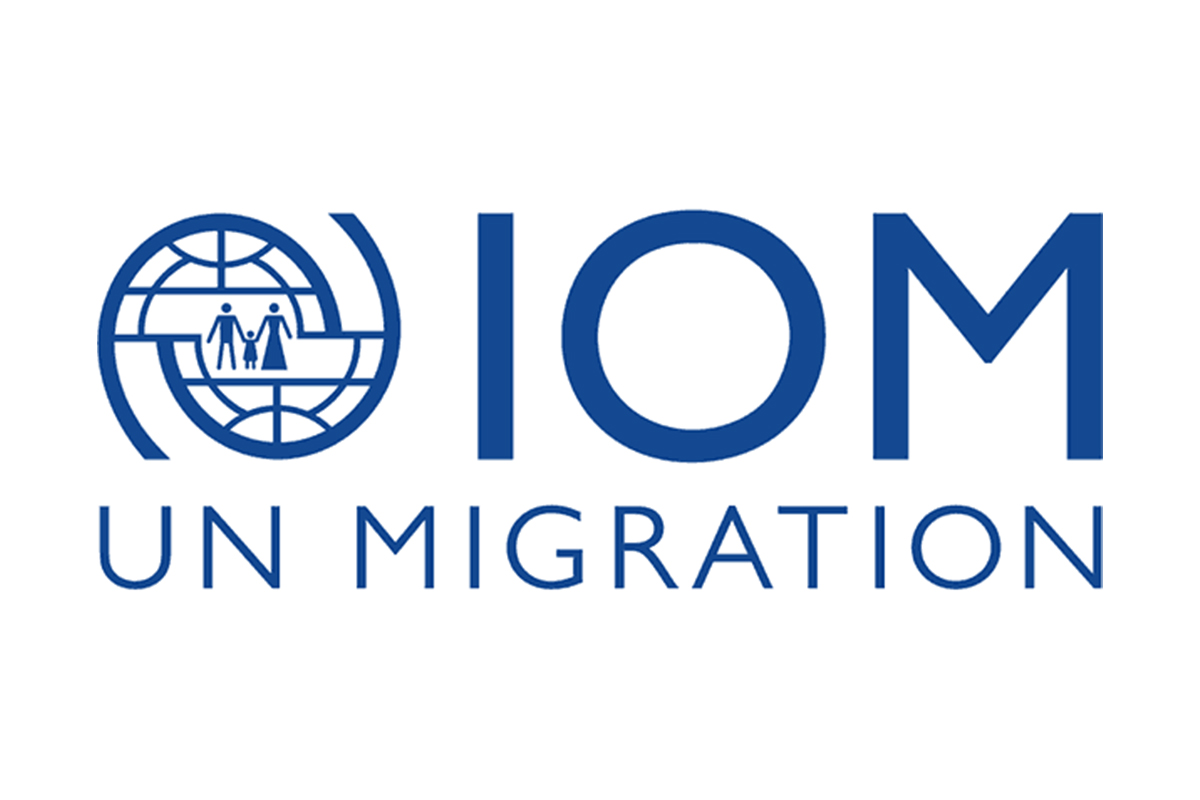
Grow Salone was contracted by the International Organisation for Migration, a United Nations organisation in Sierra Leone, to conduct Microsoft Excel training for several members of their key head office staff.
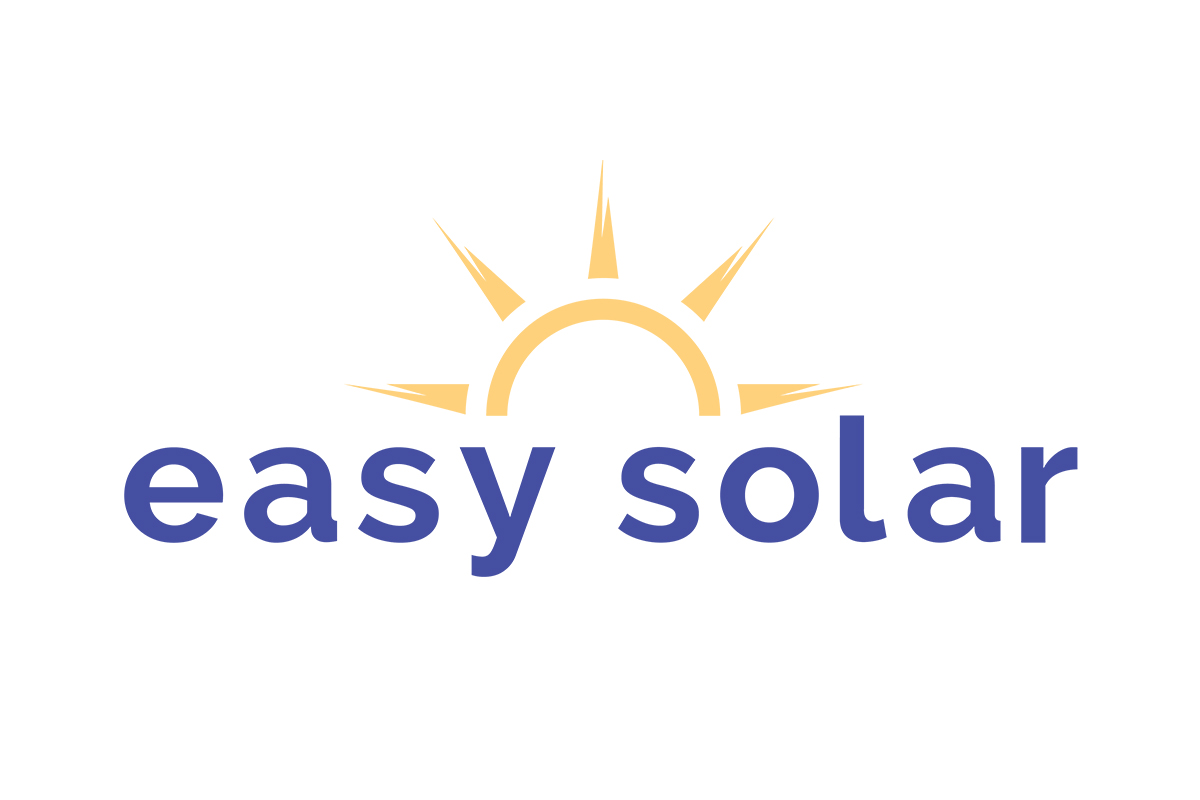
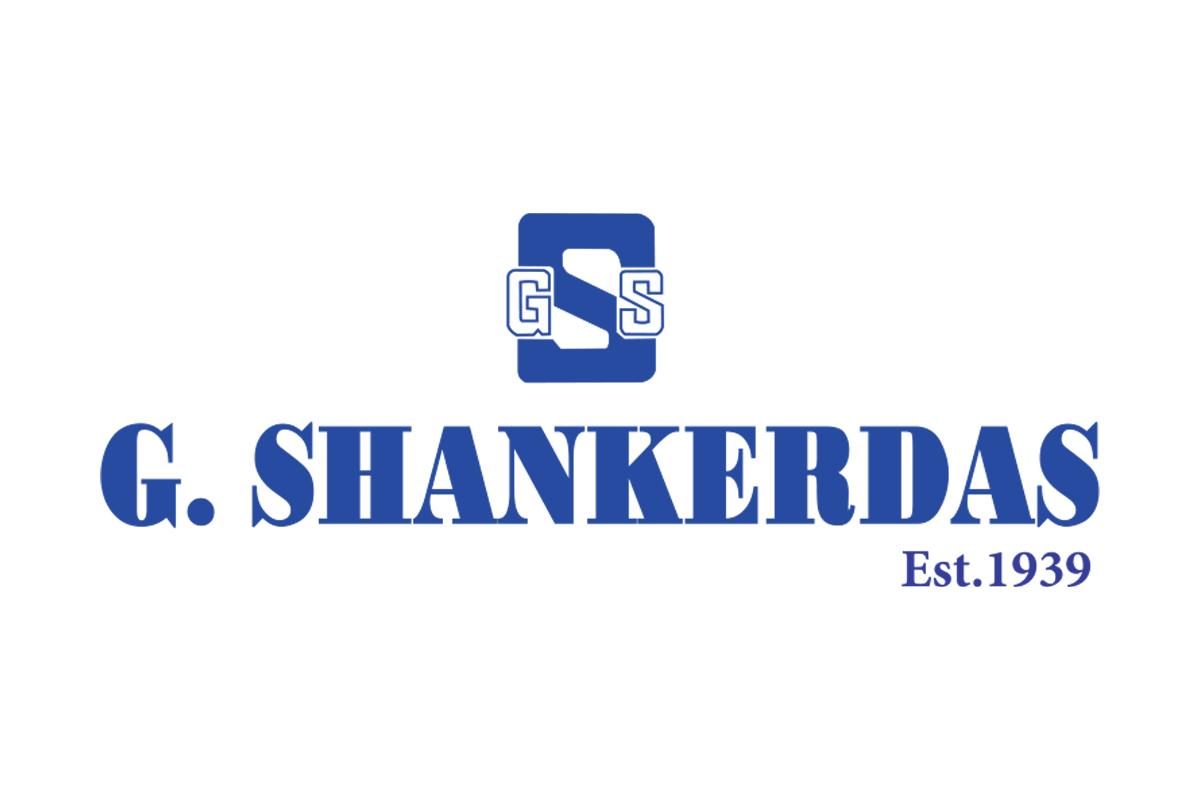
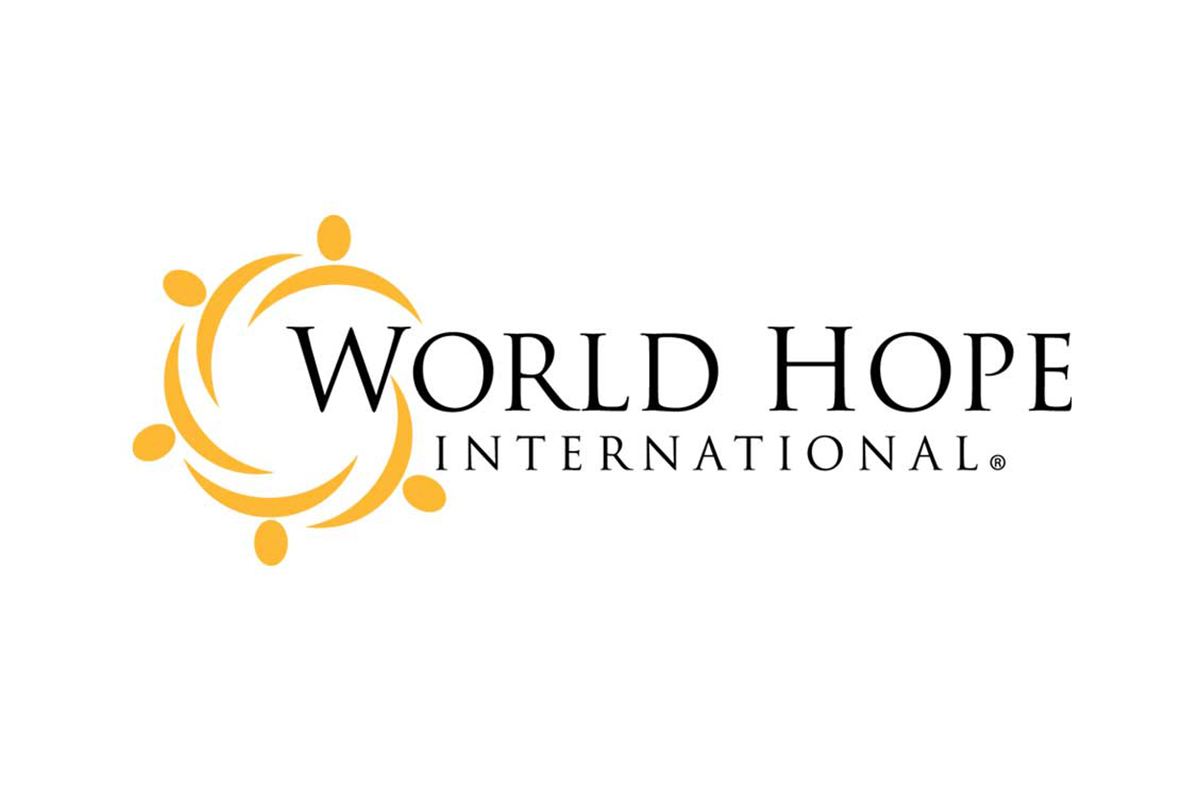
EducAid operates residential schools for the most needy children in Sierra Leone, regularly achieving some of the nation's highest grades in public exams.
EducAid also supports government schools through teacher training programmes that cover academics, holistic learning and positive learning management.
I haven't completed this section yet, but I will briefly summarise the projects that I was involved in below:
This was the first of many systems that I built for EducAid. I processed 15 years of donor data and developed a CRM system to track monthly donations, generate fundraising reminders and provide insights on fundraising event conversion and efficiency.
Using Google Sheets, I built and deployed a student tracking system across >3000 students at 11 schools in 5 districts in one of the lowest-resourced countries in the world. The report gathers dozens of pieces of data per student and reports efficiency by school, class and tutor group. This system is still in use today, nearly 5 years after I left EducAid.
When I first travelled to Sierra Leone, I was asked to conduct a thorough review of the HR systems and processes; later I was asked to implement those reforms. These included a top-to-bottom review of roles and responsibilities, a revised payroll system and introduction of a functional performance-management system.
Check out a video I shot and directed for EducAid in 2014:


Visit EducAid on Facebook for what's happening in the schools and around the country.
EducAid's Facebook Page
Please consider donating now; they do incredible work, and waste so little. Such a worthwhile cause.
EducAid's JustGiving PageIn 2014, just as the Ebola epidemic was being wrestled under control, I travelled to Sierra Leone to make some films about EducAid.
Whilst this is a professional endeavour, I wanted to include it here because it demonstrates my passion for film.
When I was 21 3 friends and I founded a music festival in Croatia.
Foolhardy? Yes. Naive? Yes. Chaotic? Yes. But it was an incredible experience...
Check out the lineup from 2013.

Take a look at the pictures from 2013.
At university I was encouraged by my English lecturer, Keston Sutherland, to be creative in my dissertation.
What struck me about Beckett's work was how his texts created turmoil, anxiety in the reader. This essay, and the audio investigation I undertook to write it, investigates why.
Throughout his work, Beckett lamented the frailty of language and his inability to create anything true or real. My study revealed that, in fact, the mistakes that participants made when reading his prose reflected their inner concerns. On the final refrain of this triptych "Time and grief and self so-called. Oh all to end.", each age group had a clear clustering of errors. The eldest group omitted, misspoke or stumbled over the word "Time". The 18-35 age range made a mistake on the word "self", whilst the youngest group's errors were scattered throughout the sentence.
I argue that, in fact, Beckett had achieved truth in his prose by bringing out people's innermost concerns: the youngest are fearless, the young adults are concerned with their identity, and the eldest are concerned with their mortality.
Below you can listen to the audio recordings, and the comments of the participants in my study. Note the levels of anxiety and discomfort that they showed immediately after reading the piece.

In October of 2022 my buddy, Alex and I flew to Sierra Leone to bring back his Toyota Landcruiser, Myrtle. Over the course of a month we travelled through the jungles of West Africa, across the Sahara Desert and up through Europe into the UK. These were the best of times.
We created a WhatsApp group with friends and family to keep them up-to-speed with the highs and lows of the West African Roadmen; a blog of sorts. Here it is...
Before we set off we have quite a few things to get sorted.
Alex had travelled out a couple of months ago to give Myrtle a once over - charge the battery, change the oil, grease the nipples etc. etc.. It was left to me to try and manage a few of the other outstanding issues like fixing the speedometer and procuring a few other replacement parts and tools we might need for the journey. Let's see how we do.
Oh, yes. Alex decided to wait until we reached the sweltering tropics that our AC wasn't working, but that he'd brought a replacement condenser to fix the issue. Let's see how that goes...
We also have the small matter of getting the Carte Brun - an ECOWAS insurance card that will take us all the way to Senegal - and also our Guinean visas. If you've ever dealt with West African bureaucracy, you might think that 4 days is leaving it a little tight to get a visa and insurance. You might be right...
Enjoying some vino in Freetown...
Still waiting for the Carte Brun and last chance saloon to get the AC fixed.
At least we're able to see friends and enjoy some vino in Freetown...
AC fixed! Speedo not... Kudos to Junior who managed to replace the entire AC system with non-standard parts and made it both fit and work...so far.
After some (polite) harassment of ECOWAS, we scored our Carte Brun. Big up to Mr Kallon who worked tirelessly on all documentation.
Packing took a while but we are FULLY laden. Good thing we have a tractor engine.
Should be in the Sierra Leone border town, Kambia, in 3 hours; ready for an early border crossing tomorrow.
Staying at the Hotel Moriya. Unfortunately no power available, so it’s a nightcap under camping light...
10 mins from the border. Aiming to adjust the suspension, fill the tires (thanks Dave Schnabel for the compressor) and head to the border by 8am.
After our first press of road coffee, we made the short distance from Moriya to the border.
Around 2 hours of border business in rusty French, and mistakenly leaving without having obtained either countries’ Interpol authorisation, our second attempt to enter Guinea was successful.
After about 100m we encountered our first shakedown attempt. Alex, sincerely, insisted “je ne comprends pas”...over and over until the gendarmerie got bored. A tactic we shall continue to employ.
AC not getting cold. We have a leak. Will try to resolve in Dakar before the desert.
Had a delicious beef stew on the roadside for brunch, sorted out sims and we’re off!
En route to Labé now. We opted for the shorter but rougher road because we’re here for a bloody adventure!
Our adventurousness nearly cost us today. After the reasonable roads near the border, our expedition went very remote. Wide graded roads degraded into winding, pitted and potted lanes.
Guinea is the most unmapped place I’ve ever been with the worst roads - not an enjoyable mix... Fortunately for me, I don’t hold the Laissez-Passez and therefore can’t drive here; Alex drove all 9 hours today - absolute champ.
The first time we passed Degui we ended up down a steep track into a valley. With the road conditions worsening, we decided to retreat. Alex attempted a 16-point turn and we were stuck - high and wet. Only Myrtle the Turtle and her low range 4x4 got us out...
The second time we passed Degui we were optimistic, even confident. When we came across the fallen tree in the road Alex assessed the situation and took us on the bike path (check out the video). Having passed the tree, we came down a hill into sight of a small village. Unfortunately the bridge had collapsed and we could go no further. Another turn, another pass around the tree, another visit to Degui.
The third time we passed through Degui we stopped for directions. Upon clearly being baffled by the directions - “follow the road to the mountain ” - we almost bit his hand off when he offered us a motorbike escort. In exchange for 50,000 francs (~£5) we followed them all the way back to a graded road. Relief!
We can gloss over the fact that the graded road also degraded into a hellish, darkening nightmare, and that the “main” road to Kindia was equally bad. Finding a suitable hotel was also a challenge - the hotels exist, but they are simply not where they say the are...
Guinea is one of the most frustrating places to travel, but it does offer up some pretty incredible scenery. I didn’t keep count, but I reckon that the phrases “oh my god this place is beautiful” and “I f***g hate Guinea we’re uttered in about equal measure.
Anyway, we made it! The car was phenomenal, only surpassed by the driving. Amazing experience, but not one I want to do again...
We arrived in Labe, a day late and a dollar short. After some early morning tinkering, greasing, and giving Myrtle a once over I decided to baseline the old girl. Had planned to do it Freetown but we ran out of time before the weekend.
A dollar short: the day on the road started off by going the wrong way down a one way, and a stern few words from the police captain. After a "fine" we pushed onto the mechanics to change oils and filters.
Myrtle is holding up well, but with one suspension air bag line cut by a sleepy Salone mechanic, she's wonky and the extra ton of weight is hard work on the suspension and shocks that I should have changed.
Still, despite sounding a bit throaty due to a Guinea-road induced hole in her exhaust, she's purring along nicely. 30 next year!
We climbed from not far off sea level to about 1,000 meters today, along steep roads littered with trucks on their sides that must have had their brakes checked by the same mechanic who cut my air lines.
After a quick stop for lunch we cracked on for a rainy drive along some grassy plains and horrendous roads to Labe, arriving at 6.30 as it was getting dark. We thought Abdulai at the hotel was being rude as we chatted in our rusty french, only to find out he's from just around the corner from where we lived in Salone and doesn't speak a word of French.
With the roads so bad we've opted for an early sunrise start rather than driving at night.
7 more hours to the Senagalese border and some much needed tarmac, so off at 4am and hopefully we'll be somewhere with WiFi early afternoon to start the work day.
Marcus has been an excellent co-pilot, keeping me in diet coke, selecting excellent tunes (with a short lived mistake when Linkin Park came on), and working out lots of trip logistics. He's also a great windscreen washer.
Onwards!
We set off in the dark at 5am to make the most of traffic free morning. Aiming for Dakar, we set off in good spirits despite the hour on the best roads we've seen so far in Guinea; the sleeping policemen (speed bumps) in every village weren't a surprise. The sleeping cows, sheep and dogs every few meters were less expected...
We were forced into an earlier than expected coffee break when we entered into a wide flatland, and the sun started to rise. It was pretty spectacular!
After this stop and a brief climb, the tarmac turned into a and much rougher jungle climb. As we crested the pass, we descended into the mist on the other side.
They had clearly had some substantial rains when we were greeted by a deep muddy stretch littered with 5 or 6 stuck vehicles and 30 vehicle traffic jam.
We assessed the situation, deflated Myrtle's tyres, pulled a minibus out of the mud, and zig zagged our way through the carnage. Marcus once again earned his stripes spotting me as I drove through.
I stopped to check a squeaky fan belt and saw one of the pulley wheels was loose. We tried to tighten it but with no luck. Almost out of nowhere, what must be one of the most well-travelled cigarette salesmen, Mr So, and his comical sidekick stopped to ask how we were doing. With the bonnet up in the baking heat, we admitted not well.
The duo called a mechanic and we had a brew of coffee at the roadside whilst we waited. With the help of their mechanic, we took off the fan, shroud and pulley wheel that drives our (non-functioning) AC compressor and chucked it in the back of the car. We were on our way again, one less bit of Myrtle working and the rest of her held together by cable ties.
A couple of hours later we were at the border dealing with the usual Guinean bureaucracy: 27 people in 15 offices checking the same 3 documents over the course of a couple of hours.
Having left Guinean territory we drove something like 30km to the Senegalese border post - is it all just no-man’s land? This border was an absolute breeze by comparison, with professional staff and no mystery "administrative fees". It was so easy I didn't even notice our visas has been issued.
Marcus took the helm about an hour into Senegal after a bit of shut eye, having sweated into my fresh and unused pillow, and settled into a night drive while I try to match his co-piloting skills.
We have now reached the La Relais hotel and are now within sniffing distance (~3 hours) of Dakar.
20 hours! It’s a well earned beer and soon to be a very well earned rest...
Revisionist History
Alex and I wanted to make an amendment and to shout out a huge appreciation to @Nicco SL for everything! Not only did he store Myrtl for 6 months, he accommodated, fed and (possibly unknowingly) supplied us with the necessary liquid energy to get those first few days in Freetown sorted - sorry for drinking all your fancy import beers, Nicco!
Nicco hopes to make the same trip in the future, so we’re tracking our journey for later reference!
We set off from Le Relais hotel in Kaolack around 7am, back onto the narrow dual carriageway I’d been wrangling the night before. This morning there was substantially heavier traffic with many more trucks. It was consistent but slow going.
We had been told by another patron of Le Relais the night before that there was a better, wider Péage quite close by which would speed us into Dakar. We made our way there.
As we know, speed is relative... I have been under strict instruction not to push Myrtl over 2,200 rpm which equates to roughly 80kph in 5th gear. I am not sure that the 50km diversion to the 110kph Péage was really worth it, although it meant that, in the most part, we had the whole road to ourselves.
The delaying effects of this miscalculation were compounded when I managed to turn the wrong way onto the Péage. A 40-min round trip back to our starting point was another unwelcome addition to what should have been a 3-hour journey, although we did pass some pretty spectacular Baobab trees...
Unfortunately, my co-pilot - who spent 80% of the time asleep, working or otherwise cantankerous didn’t manage to photograph any of them - fortunately, I was able to coach him on the principal function of the role, and he made some improvements.
As we entered into the industrial outskirts of Dakar Alex was asked to take a call from his work. We dutifully wound up our windows to facilitate. Within 30 seconds we were uncomfortable; within 5 minutes we were sweating; by 45 minutes I was sodden. This “work from the road” concept might need some reassessment without any AC to rely on...
Alex and I think we need to put a bit of work into Myrtl before we take her into the desert. Servicing the hubs, replacing the shocks and a few other bits and bobs. Nothing terminal, but preemptive maintenance is key. We headed directly to the Toyota dealer - closed for lunch - and then onto another workshop. Having managed to (unintentionally and illegally) cross a median to enter one of these garages, we got a firm wrist slapping from the police. We hope to return to the dealership first thing tomorrow to commence the work.
Upon leaving the last garage, and with further work calls impending, I asked Alex whether he’d booked the hotel... “Not yet”, was the response from the trainee co-pilot. Radisson Blu - full. Ibis - full. 5-star Terrou-Bi it is then...and here we are. Treat your self!
Alex disappeared to cool down and do some work. I went to the private beach for lunch and beers, and later a snooze. We re-convened for steak, cards and vin rouge. We’re playing rummy and it’s currently 1-1.
With a fairly early night, a good night’s rest awaits. A demain!
The last few days have been very comfortable, but fairly uninteresting for our faithful viewers. Alex has been working, I’ve been catching up on a few bits of admin and generally relaxing.
Our planned departure from Dakar yesterday morning was delayed until about 6pm since we had a booking in at the Toyota garage.
We gave them a laundry list of things to do, but they did not make as much progress as we’d hoped. Despite the dramatic characterisation of previous updates, Myrtle is still in good nick and we’re pretty confident of her ability to take on the desert lands of Mauritania. We are less confident of her squishy organic loads in the front seats to take on the desert heat, but we are as prepared as we can be with a fridge full of water, USB fans and a sat phone.
Yesterday I went to Isles de Goree, a slave island with a pretty interesting history. I then went on to the (fairly drab) National Gallery. Having stocked up at the supermarché, I rejoined Alex at the garage and we set off at 6pm.
We arrived into St Louis old town, the charismatic French colonial quarter of the city. We stayed Hôtel de la Poste, the French colonial post office building. It had a huge character, filled with colonial keepsakes and set around a lush central courtyard - a really nice place. We were directed to the Flamingo Bar just around the corner for a nightcap and chatted with a group of young St Louisians. It’s a really cool little place, and it sounds as though the jazz festival in June is a highlight.
Now, we are on the road to Mauritania with a mix of excitement and nerves. I’m looking forward to watch the lush greens transform into expansive dunes...
Our destination is Nouakchott, the capital of Mauritania. We should be there before nightfall, subject to a smooth border crossing...
p.s. Alex absolutely bloody loves cows
The road from St Louis to the border was easy, and the sleepy border crossing was smooth but slow.
The road into Nouakchott from the border gave us a glimpse of what Mauritania might be like. Immediately after the border we passed through the Diawling National Park - a marshy flat land full of colourful birds and a few warthogs.
The main road to Nouakchott treated us to villages with pastel houses and mosques set against small, but undoubtedly cool sand dunes.
We stopped about 100km in for a late lunch - grilled chicken sandwiches, assembled at the road side - and SIM cards from a super friendly and helpful man, Sidiki.
Passing regular, professional police stops, Google Maps took us through the industrial part of Nouakchott to our home for the night, Maison d’hotes Jeloua.
Alex semi-successfully fixed the leak in the aftermarket airbags on the rear suspension coils which gave us some much-appreciated stiffness in our ride.
Having done a bit of admin, we woke up feeling fairly refreshed. With Marie’s coffee and croissant breakfast in our stomachs, we set off on the road to Terjit.
As most of you know, the principal aim of this entire trip is retrieve Myrtle from Sierra Leone...tourism, and time to explore necessarily take a back seat since both of us have obligations and timeframes. The 5-hour journey from Nouakchott is the only planned major detour off of our homeward bound route, and it was planned by me - the pressure was on.
The drive was long, dry and hot. Alex made his first attempt at the Guinness World Record for most litres of water consumed in a day - I didn’t, and regretted it a bit later. We will both be trying today!
After 4 hours of very very drab desert - some dunes, but mostly expansive flat lifeless desert (and a sh*t load of camels) - the topography started to change.
Out of nowhere, big mounds and hills appeared in the desert haze. As we got closer, signs of life started to appear - trees, grass, goats!
We entered into a gorge, Alex doing his best to blend in, and climbed into until we came across a crack in the hillside full of trees. A sandy track through a little village and we had reached Terjit, Mauriania’s principal oasis.
Stepping into the tree-packed crevasse, the temperature dropped about 5 degrees celcius and the humidity increased. Birds and frogs hopped about the place, and we followed the track up to a small pool that had been built to collect the oasis water.
We climbed around a broken staircase and out of the top of the crevasse to get s view out of the valley, and then went to bathe. The water was cool, clean and very fresh. It was vitalising after such a long, hot day to just cool off and clean up.
We spent the night with the head man of the village, in a domed mud hut. We were given a traditional round of sweet tea, followed by an absolutely delicious meal of chicken stew and couscous.
We played a couple of hands if rummy - Alex is now winning 3-2 in the series. With a bit of a dehydration headache, we went to sleep in the hut. At least, that’s where we started. Having conked about 8pm - me more soundly than Alex - we both awoke around 3am swarmed by mosquitoes and sodden with sweat. After an unsuccessful attempt of resuscitating my mosquito-hunting technique from Sierra Leone, we agreed that there was no way we could stay any longer in that hut. “I can do mosquitoes or heat, but not both”, said Alex.
We went to lay in the porch where we’d eaten dinner, and Alex caught a glimpse of the stars. We moved the mattresses out and gazed for a bit - we reckon we saw about 2 dozen shooting stars that night. Some long bwoiz, some fast bwoiz, some bright bwoiz. We got a bit more kip and woke about 7:30am.
A quick bite of flatbread and honey with some coffee and we’re on the road again. We are a day behind schedule so decided not to drive the 4-hr road to Ouadane and the Richat Structure - a shame, but with a long drive back to Nouakchott and on to Nouadhibou today it’s for the best...
p.s. Alex bloody loves a camel. I’m quite partial to a donkey. We both f***g hate mosquitoes.
We made it into Nouadhibou on Sunday night (Day 14) at around 11pm. One of the frustrating things about West African travel is the hotels...; even those that appear to be fairly high quality most often do not have any phone numbers listed online, nor do they have accurate map locations. Arriving into a new and unknown city after a long drive and little food, and then being unable to find your hotel must be one of the most maddening experiences that overlanders have to face in this region.
The fact that we then had to effectively explain the concept of foreign currency and navigate the newly denominated Ougiya with a receptionist who struggled to grasp the basics of addition made the check in process even more annoying. The 'Prestige Hotel' was not prestigious, but it did the job; we managed to order in some food to the rooms, have a (cold) shower and fell straight to sleep.
We awoke around 6am. A quick clean and level check of the car, implementing our new plan of brewing litres of coffee and throwing them in the camping fridge, and a quick photoshoot with Alex's best humped boy, we set off into the thick sea mist of northern Mauritania towards the border at around 7.
Alex had briefed me that we were entering into Morocco. My map, and all the scheduling had said that we were entering into Western Sahara, but for those at the border it was most certainly Morocco. The history of this disputed territory is interesting, so take a look if you get bored...
Alex had suggested a plan: the road up the coast of Western Sahara is pretty dull. Mostly flat scrub lands. Let's forget this scheduled bit-by-bit approach of driving 6-8 hrs a day, gradually making our way up to Morocco - let's blast through Western Sahara and straight up to Essouaira in central Morocco. It was going to be a long drive - 22 hours according to Google Maps, and this did not account for the border crossing and the likely police stops throughout the territory. However, armed with our new rally-style shift driving (2 hrs on, 2 hrs off), we thought that we could do it safely.
We reached the border at about 8:30, just in time for opening, and proceeded through the Mauritanian side fairly swiftly. We changed a bit of cash and made our way through the no-man's land - apparently the most land-mined region in the entire world (seriously, read the history of Western Sahara)...
As we approached the Moroccan border I said, tempting fate, "this is going to be quick"...it was not. IT systems failures, bureaucratic processes and some lackadaisical staff meant that we were there for about hours. I managed to procure our insurance and some sim cards while Alex waited with the car. Having learned our lessons from the night before, we stopped to get some food - grilled meatballs with flatbread and yoghurt, followed by some tea.
We set off! Eating up the klicks. Border -> Dahkla -> Laayoune -> Agadir -> Essouaira. We stopped for a quick bite of leftover pasta from the night before atop some cliffs overlooking the beach just north of Dahkla and spoke to some fisherman inflating their truck inner tires ready for a night of squid fishing. We stopped in Laayoune for a grilled lamb meal and to withdraw some more fuel cash. Litres of coffee, energy drinks, podcasts and tunes helped us drive through the night and into the morning - 30 hours on the road!
The cliff-top lunch stop was definitely the highlight of the trip, although there were a few lowlights...
At a refuelling stop, we discovered that the transfer case (attached to the gearbox) was leaking. This was most likely due to the Toyota garage in Dakar overfilling the grease in the prop shaft and put pressure on the seal - a quick top-up and tighten was a sufficient patch and we went on.
The petrol filling cover is a bit sticky; it's been a running joke that I have the 'magic touch' for opening it. During the aforementioned stop Alex simply could not get the cover open - I was pulling on the lever from the driver's seat and he could not get it... We switched positions, and I opened it first time. Magic! About 100 metres down the road, at about 80 kph, the bonnet flew open and damn near came off. Had I been opening the bonnet instead of the petrol cover the whole trip, or do I really have the magic touch? We still don't know. Anyway, it was a pretty dangerous situation which fortunately did not come to anything... We managed to close the bonnet once we'd bent it back into shape; it developed a bit of a rattle, but it does the job. I will be more attentive in future - lesson learned.
At about 3am, as we were passing through the northern part of Western Sahara, a thick soup-like mist descended onto this coastal highway. The speed limit was 120 kph, we had about 3 metres of visibility and were moving at less than 30 kph. Fortunately, the roads were absolutely perfect and nearly empty - we were more concerned about hitting a camel..! The locals - in their cars and their trucks - are set up for this. Covered in wide, high beam lights they know the roads and are able to penetrate the mist. We were not... Going slowly, we would wait for trucks to appear from behind us and tail them - using their bumper as a bull bar for any unsuspecting camels and their rear lights as a guide - not the first time we've had an escort this trip!
Throughout Morocco, they have well-built, new roads. Unfortunately, they have decided to not build run-offs from the main roads, and therefore drop the speeds of these main arteries from 100kph to 40kph regularly, and often arbitrarily. Facing a very nice and gentle but officious police force, without a speedometer, became quite the challenge. I managed to get caught going 70kph in a 60kph zone. The officer was almost apologetic when he wrote us the 150 Dirrham ticket (~$15), which we paid and moved on. In some significant frustration, I downloaded a speedometer app for my phone and stubbornly stuck to the speed limit.
We kept in good spirits, supporting one another when we awoke from our off-shift naps, and were both pretty proud when we wound into Essouaira around 3pm yesterday afternoon - ~1,700km in 30 hours.
We will likely be in and around Essouaira until Saturday. We have some updates from here, but we'll save them for another post...
After our long rally drive we thought that we deserved a bit of time in one place. That, and the fact that we had both been neglecting our various desktop duties a little more than we were comfortable with.
I’m not sure that we had anticipated spending 10 days there, but we found ourself a wonderfully situated, well-appointed and cheap riad set against the coastal wall of the medina. By the time the weekend came around we weren’t quite ready for more driving and frankly we took more interest in the culinary and grape-based delights that this colourful seaside town offered. We cancelled our trip into the interior in favour of an indulgent weekend.
Weekdays were filled with work. Alex on calls and me trying to get my head around HTML, CSS and JavaScript from various sunny spots around the riad.
We managed to sample some really good food, despite neither of us particularity enjoying the local cuisine. The standout was definitely Umia to which we were treated a celebratory meal - thanks Dad!
We did a little gift shopping, Alex bought some (as yet unsent) postcards - bets on whether they’ll ever make it into the post, anyone? Alex went surfing a few times, including an early morning trip to Sidi Kaouki. We played quite a lot of cards with me pulling away 7-4 in Rummy. Alex took some money off of me in a “devastating” game of heads up Texas Hold ‘Em.
One thing that I’ve observed is that Alex’s is becoming more and more like his preferred desert dweller. Alex can subsist off nothing but Coke Zero and coffee for days on end. Just like the camel, however, when the stony expanse offers an opportunity to feed, he can gorge! Filled with fermented fruit, Alex can eat 2-3 times his own body weight in a single sitting. A remarkable creature in some of earth’s least hospitable lands.
We left Essouaira at 6:30 this morning feeling rested and ready to hit the road, despite a little bit of a hangover...
Our ferry to Sète in southern France departs from Tangiers on Saturday. We’re heading for Asila today with a few stops en route to accommodate for work responsibilities.
This is the final push! We’ll be setting sail for Europe tomorrow!
Asilah is a charming, Spanish-built medina town about an hour from Tangiers. We arrived during golden hour and took a walk around the walled city, soaking up the last of the days rays.
A quick Flag (or 3) and we set off to find some food. With the best intentions of an early night, wine was drunk, food was ate and we ended up back at the riad quite late for afters.
We woke up mid-morning - a little worse for wear - heading towards the port of Tangiers. We arrived around midday and flew through the passport, Douanes and security checks and entered the queue. I popped off to get us a sandwich. When I got back, Alex had met an Italian fella called Dave towing a trailer with several motorbikes on the back. Dave runs a touring company whereby he’ll organise a road trip for his clients, ferrying their bikes to and from their preferred destination. A nice gig! Dave had some delicious Belgian beers on ice that his party hadn’t finished - we obliged and shared stories.
Several hours of waiting, and a disappointing sandwich later, we were boarded onto the Excelsior by about 6pm in advance of the anticipated 7pm departure.
7pm. 8pm. 9pm. 10pm, and we had set sail. We’d heard that there were significant storms churning up the mid-Mediterranean, so we decided to accustom ourselves with the ship’s amenities whilst in port. Nothing was open - the pool, cinema and casino were all permanently shuttered. Fortunately, the bar was open and we’d brought up the poker set from the car.
We met Thierry, an experienced French overlander who’d just been traversing the dunes in North Eastern Morocco with his family. He had told us that his wife and a friend had completed the Gazelle Rally earlier in the year, an all-female race which prioritises navigation and driving skill over pace - the course has a series of checkpoints and participants are judged by kilometres travelled rather than by how fast they are - a cool concept!
Thierry didn’t speak a word of English, but we hung out with him throughout the evening and most of the 36 hours we spent on the ferry.
Much of our time was whiled away topping up the tan, playing poker or enjoying drinks. Two of these activities were usually enjoyed together, on one occasion all three!
Destined for Sète, we were to make a stop at Barcelona. (The mighty) Arsenal were due to play Chelski at 1pm on Saturday, and I was curious to know whether I’d be able to pirate enough internet from the Spanish mainland to stream the game on internet radio. Success! Wearing my Arsenal shirt on the port side deck, I managed to listen to most of the game! Up the Arse!
After that, we returned to our usual routine. The Roadmen World Poker Series ended 4-2 to Alex, with Thierry losing his first ever hand to us on one occasion...
The 8m waves never came to be, nor did the massive delay that was expected. We arrived into Sète port at 10am - right on time. We had anticipated that the French customs were going to present one of the biggest challenges to our progress. We couldn’t believe that they would let two English blokes in a Landcruiser with Sierra Leonean plates, whose life card/log book was strewn with errors (VIN number, date of manufacture etc.) just saunter straight into the country with no checks...but they did. We couldn’t believe it! We didn’t even stop as they waived us through. Probably a fair dose of white privilege, but we weren’t complaining...
After a quick coffee stop, we bought insurance and set off towards Calais. After a couple of hours and some lunch, it was time to swap. We thought we should just double-check with the insurance company that I was permitted to drive; the answer was categorical:
Q: Is another, unnamed driver covered?
A: Non!
Q: Can we add another name driver?
A: Non!
It was going to be a long drive for Alex.
After about 12 litres of coffee, 6 litres of water and a pint of red bull we made it to Calais. Alex put in another epic shift: over 1,000 km in about 15 hours, including having to drive directly through the centre of Paris due to a 2m height restriction on the motorway. Fortunately, at 12pm on a Monday night in Paris, the streets were deserted and it didn’t set us back too much.
We arrived and both collapsed. We both worked on Tuesday, and cleared out Myrtle in preparation for loading her on to the trailer. We finished off the West African Rummy Championships, European leg; I closed the series out with a strong finish: it ended 10-6 to me!
This morning, at 7am, Myrtle was loaded onto the trailer and we were packed into our courier’s car. A somewhat zany bloke from the West Country called Matt - quite a lot of rambling for a rainy morning, but he had some cracking one liners...”Prince of Arabs”...” Intermittent faults “.
Passport and customs checks were easy. The train was quick. Peter (Alex’s dad) came to pick us up, and take on some of Myrtle’s weight to try and get her under Matt’s approved load and kindly dropped me to Ashford International.
It was time to say goodbye, and close the book on what has been an incredible trip!
The journey home was smooth and quick...for me anyway. Alex, Peter (and presumably Matt and Myrtle) were disrupted by some protests on their way back west, although Alex has told me that they have now arrived safe and sound.
What an incredible journey! Thanks to Al for having me along, thanks to Myrtle for getting us home, and thanks to y’all for following along and all your positive feedback!
Yummy!
Until next time, blaady buddies!
I was fortunate enough to live in beautiful Sierra Leone for 5 amazing years. In that time I travelled the country, got to know its people and - I hope - to create some positive impact through my work.
Sierra Leone is also the place that I met my beautiful wife, Kristie, to whom I got married in April 2023.
I will build out this section with more details soon, but for now just check out a compilation of photos that Kristie put together to remember her 5 years in Salone.
When I was 19 I spent 6 months travelling around South America.
It was one of the most formative trips that I've ever taken, and I look back at my journal with fond memories.
I will build out this section with more details soon. For now, take a look at the pictures.